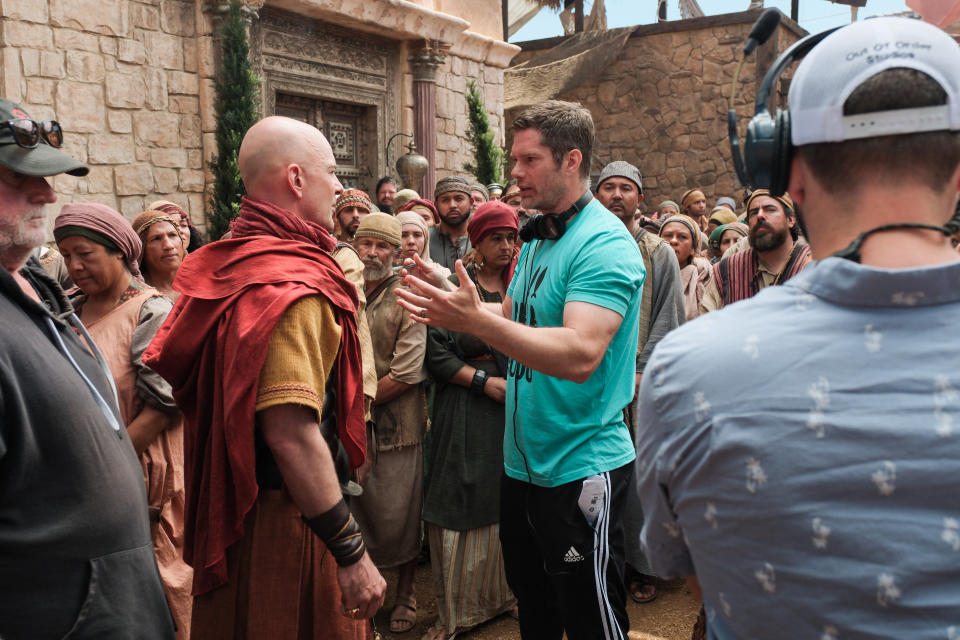‘The Chosen’ Needed to Recreate Jerusalem — So It Called The Church of Jesus Christ of Latter-day Saints

“The Chosen” has cornered the American market for Biblical cities.
A historical drama about the life of Jesus, the series is a phenomenon partly because it constructs its first-century settings with such care. The sumptuous visuals deliver the sheen of prestige TV, which has helped garner over 200 million viewers, not to mention the attention of platforms as diverse as Hulu, Netflix, and Peacock. They’re all streaming at least part of the first three seasons, while Season 4 was screened in cinemas this spring in advance of its streaming debut June 2.
More from IndieWire
To maintain its production standards, the show has constructed a 1,200-acre backlot in Midlothian, Texas. It’s an impressive facility, at least judging by drone videos producers have released, but it doesn’t give “The Chosen” everything it needs. The series also films at a replica of ancient Jerusalem that’s part of a motion picture campus in Utah owned by The Church of Jesus Christ of Latter-day Saints. Add in the moments shot at outdoor locations, and “The Chosen” is enacting Christian history across an enormous swath of the United States.
It wasn’t always this way. “In Season 1, we had nowhere to go,” recalled James Cunningham, the show’s production designer. “There was this little place called Capernaum Studios near Weatherford, Texas. It was this tiny little replica of part of Capernaum, and we shot most of Season 1 in that little space. And we really shot the heck out of it. We could only make the spaces look so different for so long. That’s what prompted us, in Season 2, to find the place in Utah, which [the church] was generous enough to let us use. And then we needed more space, which was what prompted us to build our city back in Texas.”
Wherever they’re working, the creative team wants “The Chosen” to feel removed from modern times. “The detail and realism of our home interiors and synagogues contribute to our obsession with authenticity,” said series creator Dallas Jenkins. ”And the beauty of our outdoor locations especially is that they make it easy for the actors to feel like they’re breathing in a 1st-century space. They can look almost anywhere and not see the 21st century at all.”
In Season 4, Cunningham used an excavation site on a Utah mountain to replicate a pagan temple near Caesarea Philippi, site of the Confession of Peter. He visited the actual historical site for research and then set about constructing his own version from wood and styrofoam. “We got a sense of the scale and how imposing it was,” he said. “Some of the actors said it felt almost overwhelming, which is what we wanted them to feel.”
There have been similar reactions to the replica Jerusalem, which is in Elberta, Utah, near Goshen. As site manager Dave Neyman explained, “That set is part of our church’s mission to bring people closer to Christ, so we treat it with a great deal of respect. We had our leadership [team] dedicate it as a sacred space to do work. I remember some of ‘The Chosen’ crew, when they walked on the set at the start of Season 2. One of their guys said, ‘This is a God-honoring place.’ And that terminology really stuck with me.”

That’s not something you hear from a crew shooting, say, a crime procedural. By representing holy ground, these sets can be meaningful to people of many faiths. Neyman recalled eating lunch with some of “The Chosen” team as they discussed logistics for an upcoming scene. “I was really struck by that moment, because here I am a member of the Church of Jesus Christ of Latter-day Saints, and I’m sitting across from a Catholic,” he said. “He’s sitting next to an Evangelical and a Lutheran and a Jewish man. And I said, ‘Well, regardless of where we come from and what we believe, we’re all here together, sharing a meal and collaborating on something.’”
Still, as authentic as it tries to be, “The Chosen” isn’t a documentary, and Cunningham certainly brings his imagination to his designs. “It’s kind of freeing, because in some ways you can make your own world,” he said. “We can study things to a point, but the truth is we don’t really know what things looked like in 70 A.D.”
As they craft everything from wall hangings to bowls and baskets, the team has studied the ruins of ancient cities like Pompeii and Herculaneum, as well as design trends that are only a few centuries old. “A lot of the furniture used in the Victorian era was based on Pompeii,” Cunningham said. “They excavated a lot of Pompeii in the late 1700s, early 1800s, and that piqued everyone’s interest and influenced design. We can buy Victorian furniture and change it up a little.”
The color palette of “The Chosen,” in particular, gives Cunningham the space to be creative. “On the first season, we started with more brown tones, because we wanted people to feel the oppression,” he said. “And then as we’re moving towards Jerusalem, we keep adding more color and more color, just to hopefully bring the 1st century alive to people.”
Cunningham acknowledged that some viewers might be startled by his color choices. “Some of them are pretty saturated, and I’ve had people criticize me for that. But I think, ‘Well, prove to me that they didn’t have saturated colors.’ To me, that’s part of what makes it fun. We take a few liberties, but it’s always done in service of the story.”
Best of IndieWire
Sign up for Indiewire's Newsletter. For the latest news, follow us on Facebook, Twitter, and Instagram.